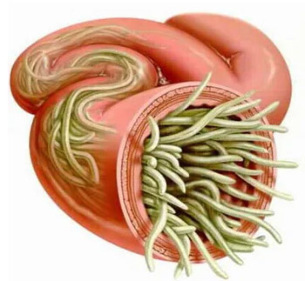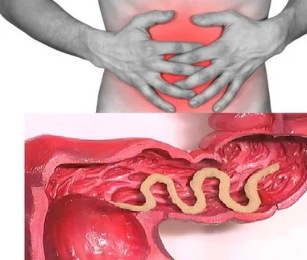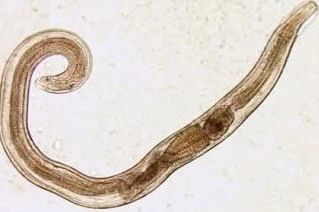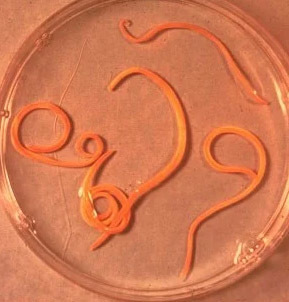To this day, science knows of the order of 280 species of earthworms, able to develop and live in the human body, the disease in the different organs and tissues. The incidence of infection by worms of man are dependent on climatic conditions and socio-economic conditions of particular regions (in the under-developed countries, especially those located in the tropical and subtropical area, the level of parasitic infections is much higher than in poorer countries).
The means of the infection of human helminth infections:
- Bioelements (infection of the animal).
- Contagious helminth infections (transmitted from person to person).
- Geohelminths (diseases of the levy to parasites, with one of the cycles of life in the soil).

Factors influencing the manifestations of helminth
A way of penetration of the parasite into the body:
- The degree of adaptation of the worm to the human body;
- The density of the population (in number) of parasites individuals;
- Habitat worm tissue parasites live in the soft-tissue thickness, and projection to screen live in a breakaway of light hollow organs). Some helminth parasites in the different phases were translucent and fabric form. The larvae and the development of a phase to tend to cause pathologic changes are more pronounced.
In the absence of reinfection number of adult parasites in the human body does not increase. This is a feature that distinguishes truly worm infestations diseases caused by bacteria, viruses, fungi and protozoa organisms.
Intestinal worms in humans: symptoms
Helminthiasis is a disease that is characterized by 2 the current phase (acute, from two weeks to two months) and chronic (from a few months to several years).
The symptoms of the acute phase of helminth infection
The first signs of the disease may manifest itself in different times (most often after 2-3 weeks, when the ascariasis – at the end of 2-3 days, and when the disease the incubation period can last from 6 to 18 months).
In the acute phase of a parasitic infestation the more a characteristic symptom is an allergic reaction (causes production of antibodies to antigens migrating larvae of parasites). It was often infected to people on the skin appear itchy skin rashes, are likely to retidiviruuschem downstream, increase the lymph nodes of the technologies locale, you can meet generalized or local swelling, muscle and joint pain. Also the migration of the larvae of the parasite can cause pains in the chest, coughing, attacks of choking, disorders of the chair, nausea and vomiting.
At the same time, the acute phase of helminth infection may be accompanied by more serious violations (severe forms of pneumonia, hepatitis, myocarditis, hepatosplenomegaly (enlarged liver and spleen).
In the blood, increases the number of eosinophils (eosinophilia), and disrupted normal proportion between the protein fractions (dysproteinemia).

The signs of chronic helminth infection
The symptoms of chronic phase directly depends on the organ that is "inhabited" by the parasites, as well as a role of their size and number.
Thus, when the parasitism in the intestines of the rare individuals of the disease can be asymptomatic (with the exception of cases of infection of very large parasites). The characteristics of the chronic phase of the helminth-intestinal are the dyspeptic disorders. In children is more expressed asthenoneurotic syndrome and the pain. When infestation is massive roundworms may be the development of the mechanical bowel obstruction, jaundice and pancreatitis.
Consuming all the necessary for his subsistence of a substance of the body of the host, helminth parasites are the cause of digestive disorders, malabsorption of vitamins, minerals, carbohydrates, proteins, and fats. At the same time, the waste material to the depressed normal microflora of the intestine, and reduces the immune power of the body.
In people with helminth infections, because of the weakening of the immunity and of the intensification of the process of cell division (continuing survey of recovery damaged by parasites of tissue) significantly increases the risk of the development of the institute's malignant.
Types of wormers, parasites in the human body
Of the helminths of man are the 2 types of roundworms (nematodes) and flat (tape drives and the moat).
Roundworms
Pinworms
The parasites are the cause enterobiasis small (up to 10 mm) thin abdominal worms, with grey-white coloring. Infection occurs by the (for the mouth). The reason for this – the hands are dirty. The eggs of the parasite can remain in the soil, on wool of infected animals, fruits and vegetables, and others, however, the enterobiasis it is not uncommon to samsarajade (especially in children), resulting in scratching of the areas, a follow up to the ingestion of eggs. The larva pinworm develops in a period of two weeks in the digestive tract. Transformed in, the adult worm parasite in the departments of the fine and of the departments of the colon.

Roundworms
The ascaris is a large parasitic fusiform shapes in colors red and yellow, up to the age of 40 cm (females) and 15 to 25 cm (males). Not having suction cups or other attached devices, the roundworm is capable of moving autonomously to meet food masses. The eggs, the females, the parasite stand out with the feces.
The infection of ascariasis occurs in the case of ingestion of the mature eggs with water or without washing the fruits and vegetables that contain soil particles. After the penetration of eggs in the intestine give matured larvae. Iup to infiltrate in the wall of the intestine, they reach the bloodstream to the heart, and thence are found in the lungs. Through the pulmonary alveoli larva of roundworm of respiratory capacity re-enters the oral cavity. After the re-ingestion parasite reaches the small intestine, where it develops into an adult. The worm lives on a 12-month period following dies and stands out with the feces. In the intestine of a master, may live one or hundreds of individuals.
Whipworm
The whipworm, the causative agent of trichuriasis is the to white, parazitirujushchy, in the first division of the intestine, and the coming of size 4-5 see the parasite Feeds on blood and tissue of the mucous membrane of the rectum.
The eggs of the whipworm, waiting for a female on the walls of the intestine, take out all of the influx. Their development is happening in the environment (the best ground). The eggs Mature in them by the larvae of the parasite enter the body through the, dirty hands, with water or without washing the vegetables and fruits.

: Trichinella
The causative agent of trichinosis is a small, round worms, reaching 2 to 5 mm in length. The infection occurs through consumption of poorly roasted meat, pork, bear meat, wild boar or). By penetrating in the intestine, the larva of the parasite, 3 or 4 days to ripen until the state of a Mature individual. The lifespan of the worm is 40 days, after which the parasite dies. Prosurvival of the intestinal wall, the larvae enter the bloodstream and are transported to all organs of the human body, settled in the muscles. In this case, most often affects the respiratory system and facial muscles, and the flexor muscles of the limbs.
In the first days after the infestation, the patients complain of abdominal pain. Then, after about 2 weeks, the body temperature rises to 39-40 With, the skin will appear itching, skin rashes, develop muscle pain, swells the face. In this period, in the case of the massif of the infection, there is a risk of death. After about a month of recovery. The parasite is encapsulated in the spiral form, after which, within a period of two years die.
Ancylostoma and necator
These two parasites are similar between them for biological reasons, as well as by the recipient of the disease. In this regard, they have decided to merge under the name of (hookworms). The worms, which reach a length of 10 to 15 mm, the parasites 12-p. gut. It should be noted that this is one of the most common, but, at the same time, quite rarely identified by the parasites. The larvae of helminths enter the body through the skin in case of contact with infected of the earth. Then, to enter the bloodstream, they are, just like the roundworm, migrating in the lungs, then through the bronchial tubes with otharkivajushche of sputum in the digestive tract. Ancylostoma parasite in the intestine, attaching themselves to the intestinal wall. The parasite is feeding exclusively on blood, the bites can penetrate the lining of blood vessels, injecting the anticoagulation component. One day, a great individual, on average, can absorb 0,05-0,35 ml of blood. Therefore, it is more a characteristic symptom of this helminth infection is iron-deficiency anemia, as well as the modification of the ratio of the protein fractions (dysproteinemia).
Flatworms
Broad tapeworm
This is one of the largest worms, reaching to the length of 10-20 meters. The disease is caused by this parasite, called difillobotrioz. The development cycle of a worm starts with fresh water fish or crustaceans. In the human body, which is the definitive host of tapeworm broad, the larva penetrates with caviar or infected fish net. Reaching the small intestine, the parasite attaches to the wall and within 20-25 days grows to a Mature individual.
The Fluke
The parasite that causes opisthorchiasis is a flat worm, reaching a length of 7-20 mm, it Should be noted that more than 50% of cases of liver infection Flukeom (called a cat a flute) to represent the people of Russia. The parasite larvae begin to develop after contact with the eggs in fresh water (to swallow the snails). Then, they enter the body of fish (carp, carp, bream, roach). The contamination of humans occurs through the consumption of infected fish of the meat, he has not supported thermal treatment sufficient. The larva of the Flukeet of the small intestine enters the biliary vessels, and in the gall bladder, fastened there with the aid of two suction pads.
Wave and the tsepen
These almost identical in its structure of the parasites reach a length of 5-6 meters. Infection beef tapeworm infection and teniasis occurs due to the consumption of meat of beef or pork, infected, Finnish (one of the forms of helminthiasis). The most viable, finland, presented in the form of whitish bubbles, reaching the size of 0.5 cm, attach themselves to the lining of the small intestine of man, and 3 months turns into an adult. Band parasite, comprised of over 2000 segments, is constantly increasing. At this end the segments containing eggs break and you move through the colon to the anal hole, and then come out of the anus or appear in the external environment with the feces. The most common symptoms of the helminth infection is a dysfunction of the digestive tract.
Echinococcus
For this parasite of man is an intermediate host. The worm parasite in the human body in the form of a Finnish. The final master of a cyst hydatid du – loup, the dog or cat. The infection occurs in the event of contact with the animals and with the objects of the environment, seeding the eggs a cyst hydatid. After the rejection in the intestine of them develop to oncospheres (hexahedron larvae). Of the intestine, they enter the bloodstream and are transported throughout the body.
Alveolar demand information
This parasite is considered to be a variant of a cyst hydatid, is the cause of one of the most dangerous helminthes (of alveococcosis), which, depending on the severity of the leak is similar to that of cirrhosis and liver cancer. The infection occurs when the rate of penetration of oncospheres (eggs Mature larvae) in the intestine. Here the germ out of the egg and infiltrate the intestinal wall, enters the bloodstream. Now, with a current of blood, the parasite spreads to all tissues and organs of the body (most often localized in the liver). It is here that in the larval stage starts, the stage of development (formed multilocular bubble, labrocyte). Each cell contains the embryonic head of the parasite, which little by little develop. Eurocity – it is very aggressive for the training, which is constantly growing due to the increase of bubbles, and having the ability to germinate in the liver, such as cancer metastasis.
The diagnosis helminth
The diagnosis of parasitic infestations include the following activities:
- the meticulous collection of the medical history, help you understand the possible causes of the infection;
- laboratory studies of feces, blood, content, 12p colon, rectum, and perianal mucus, muscle tissue, lung phlegm, the bile. During the analysis it may be identified in eggs, segments or fragments of parasites. However, the high content of eosinophils in the blood is also a signal of presence of helminthiasis.
- when the diagnosis of the disease, which is caused by the larval stages or in tissue parasites, are organized serologic studies (ELISA, LEAVE, the reaction of agglutination indirect immunofluorescence analysis, etc).
- to identify the helminths, affecting the tissues of the liver, is system to the ULTRASOUND, computed TOMOGRAPHY and endoscopic studies.
Intestinal worms in man: the treatment
In the acute phase of parasite infection the patient is system dezintoksikatsionnaya and desensitization therapy. In the severe forms of the disease (parasitic trematodes of the liver, trichinosis) of medical statements, glucocorticoids are used.
As a drug specific treatment, taking into account the nature of the pathogen are affected special anthelmintic chemotherapeutic agents.
In parallel to a patient, it is recommended to receive antihistamines and enterosorbents. The last step of processing includes the use of probiotics, normalizing the microflora of the intestine.
Also system to a special light (the food must be easy to digest and contain little fat).
In the period of the anthelmintic therapy of the patient requires strict adherence to personal hygiene in order to avoid a new contamination. At the same time, many of the helminth infections, treatment should pass in all the members of the family and of the persons infected in permanent contact.







































